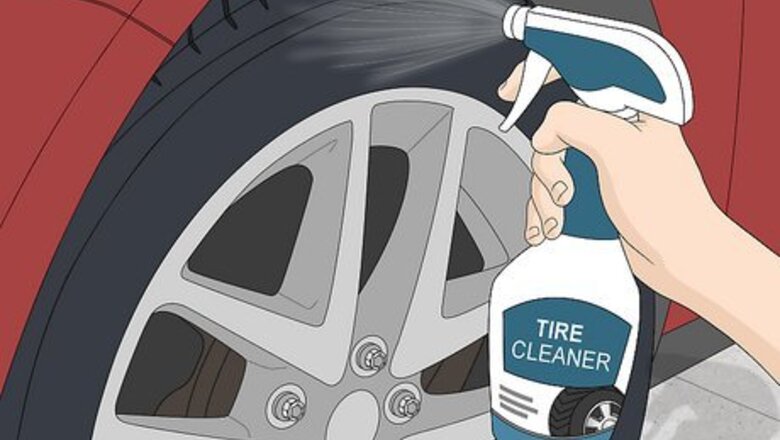
views
Using a Tire Cleaner
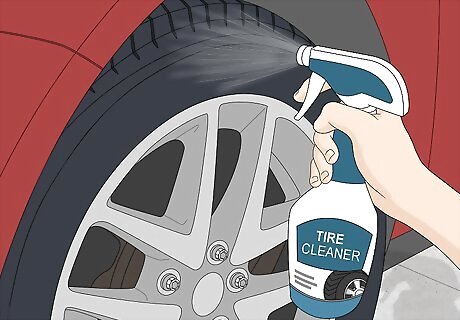
Use dish soap or a cleaner designed for tires. There are a number of products designed specifically to clean your tires. Spray tire cleaner onto your tires and follow the directions regarding how long to leave it on. Car wash soap is designed to clean and protect paint and clear coat, not rubber, so it can leave a film over your tires or prevent them from shining. Just as car wash soap does a poor job of cleaning tires, tire cleaner can have a negative effect on the paint of your vehicle. Do your best to avoid getting any on the paint. There are some cleaners designed for use on both wheels and tires. If you did not purchase cleaner designed for both applications, avoid getting tire cleaner on your wheels.
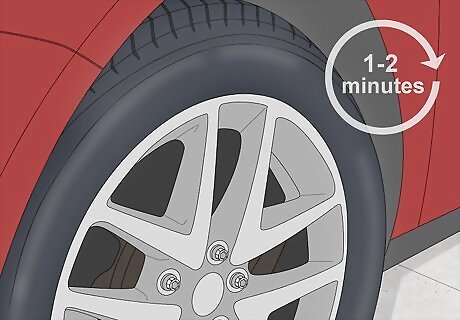
Allow the cleaner to sit for a minute. Because rubber is a fairly porous surface, it can be difficult to get the grime and brake dust off of your tires. Allow the tire cleaner to sit on the tire for a minute or two, so it can soak in and dislodge as much dirt and grime as possible. Follow the instructions regarding how long to let the tire cleaner sit on the tire for optimal effect. Wipe any overspray on the wheels or paint off immediately with a clean rag.
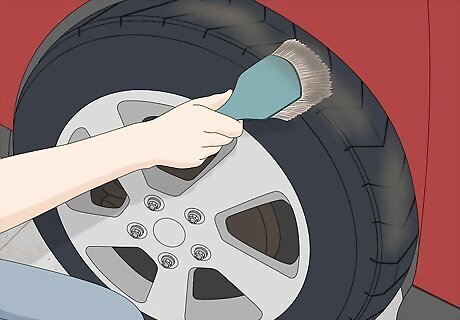
Use a stiff brush to clean tires. If your tires have a white film or have browned due to deposits of grime, you may need to scrub them to get them clean. Use a brush with fairly stiff bristles and don't be afraid to apply a lot of pressure when scrubbing your tires clean for the best results. It does not matter if you scrub your tires in a back and forth or circular motion as long as you are consistent throughout the tire. Use a stiffer brush than you would on paint, but avoid steel tooth brushes as they may penetrate the rubber and lead to leaks.
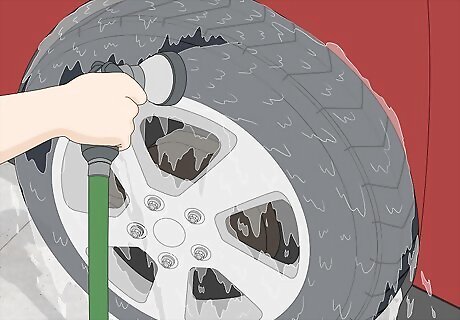
Rinse the tires with a hose. After scrubbing as much grime off of the tire as you can, use a hose to rinse the tire off. Use a power washer or high pressure hose if possible to limit the amount of dirt that remains on the tire. Tire cleaners are designed to be environmentally safe, so it's fine to allow the tire cleaner and water to drain or run off into your yard. Be sure to wear eye protection if using a pressure washer.
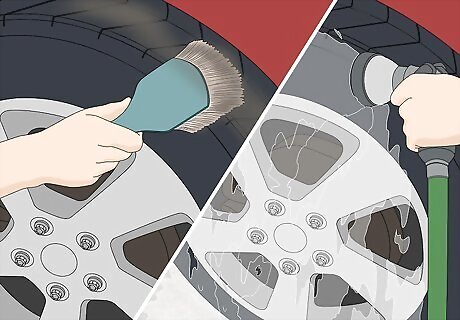
Repeat the cleaner process if necessary. After scrubbing the tire with tire cleaner on it and rinsing it off, there may still be a white or brown film left on the tire. Reapply tire cleaner and allow it to set again, then scrub and rinse the tires a second time to remove as much road grime as possible. Read the instructions on the tire cleaner you purchased. Some may specify that they should be applied to dry rubber. If that is the case, wait for the tire to dry before reapplying. Repeat the cleaning and scrubbing process as needed for your desired level of clean.
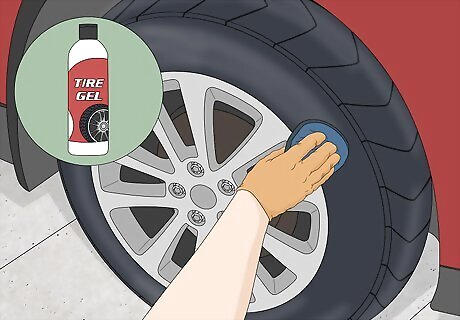
Use tire gel for browned tires. If your tires are still brown after a thorough cleaning, you may choose to use a tire gel to return the rubber to its original shade of black. There are a number of types of tire gel, but most are applied with a sponge to the entire sidewall of the tire. Apply the gel and then rinse it off one tire at a time to avoid letting it dry out on the tire. Tire gels can undo rubber browning from age. It is best to apply tire gel to an already cleaned tire.
Applying Tire Dressing or Clear Coat
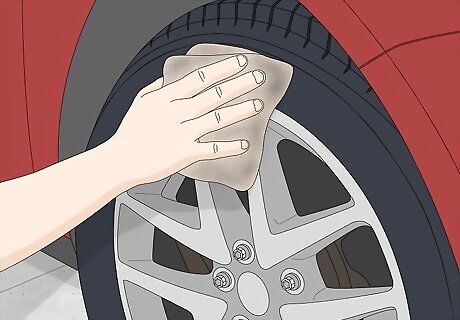
Dry tires with their own towel. Use a towel you will not use on the rest of the vehicle. Using a tire towel on the car could result in scratching the clear coat or paint with dirt it picked up on the tire. Dry the sidewalls of the tire completely before moving on. The treaded portion of the tire is not easy to see or to clean, so focus primarily on the sidewall as it is the most visible.
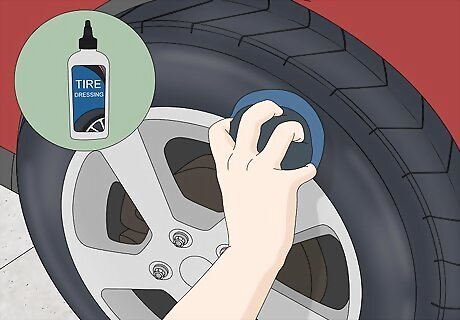
Apply tire dressing. Read the ingredient labels when choosing a tire dressing and pick one that does not contain silicone. Choose a water based tire dressing that will not provide as brilliant an immediate shine, but will require less upkeep to maintain. In nearly all applications you should apply the tire dressing evenly in thin coats using the supplied sponge by simply wiping it on as though you are painting the sidewall. You can apply multiple coats of water based tire dressing to achieve the same shine possible from silicone based ones. Follow the directions on the label for the specific brand of your choice. Allow tire dressing to dry before driving the vehicle.
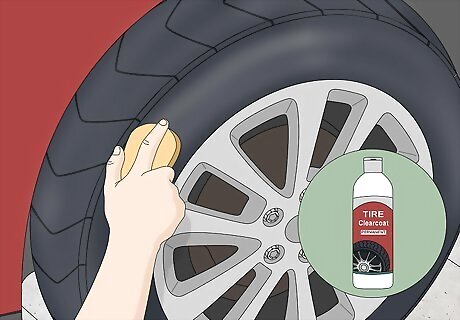
Use a tire coating or tire clear coat. Instead of tire dressing, you may also choose to apply a tire coating that creates a glossy protective layer over the rubber of your tire. Some tire coating is fairly permanent, protecting the rubber for months in even extreme weather. Apply tire coating with the supplied sponge in a thin layer over the entire sidewall. You do not need to apply much tire coating to have a significant effect on the darkness and shine of the tire. Follow the directions provided with the tire coating you choose carefully for best results.
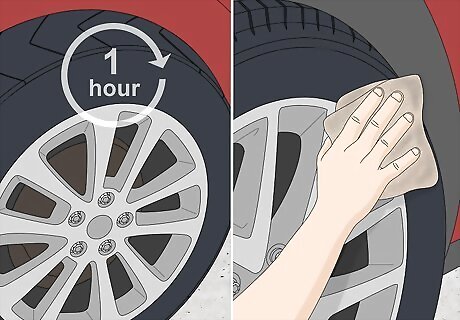
Allow the tire coating to dry, then buff it off. Depending on the brand of tire coating you choose, it may take up to an hour for it to dry. Once it has, use the supplied buffing pad or a microfiber towel to buff the tire coating off. Once buffed, the tire will look like a new tire. Buff the tire coating off in a circular motion. Some tire coating can be buffed immediately after application while others may need to dry completely beforehand. Read the directions to be sure.
Cleaning Your Tires While Washing Your Car
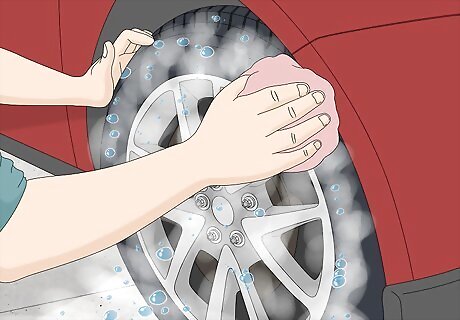
Clean the wheels and tires first. Because your wheels and tires are usually the dirtiest part of the vehicle, washing them first will prevent you from splattering dirt and grime on a clean car as you wash and rinse the tires. Washing the car after the tires gives you a chance to clean off any tire or wheel cleaner you accidentally get onto the car's paint.
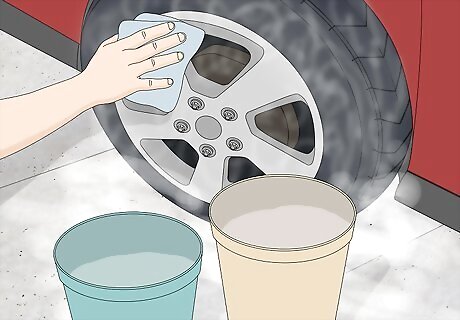
Use a separate bucket for your wheels and tires. Your wheels and tires are not only covered in dirt, but also brake dust caused by the wearing of your brake pads when you stop. This dust can create small scratches in paint, so it's important to keep the bucket, sponges, and towels you use on your wheels and tires away from those you use on your paint. Keep one bucket with sponges for washing the car and another for the wheels and tires. Never use a sponge or towel you used on your wheels and tires on the body of the car.
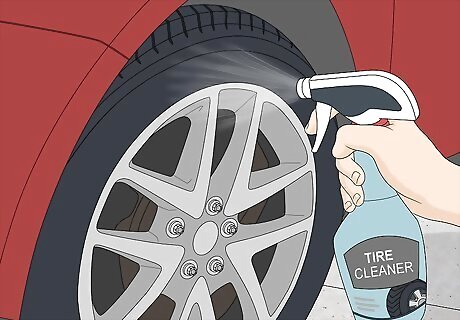
Avoid getting tire cleaner on the wheels or paint. Tire cleaner can dull paint or even remove wax or clear coat from the body of your car. It is designed to eat through stuck on grime and the chemicals can even be harsh enough to damage painted or powder coated wheels. Take care when applying tire cleaners and immediately wipe any overspray off. If you use a wheel and tire cleaner in one, it is okay to get it on your wheels. Some wheel and tire cleaner is only designed for specific types of wheels, so read the instructions carefully before spraying your wheels with the cleaner.


















Comments
0 comment